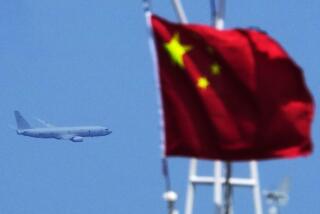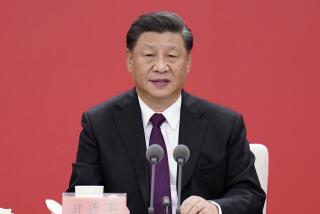Chinese Political Cartoons Hit Corruption, Ineptitude
- Share via
PEKING — Political cartoons are making a comeback in China and their targets mainly are official corruption and ineptitude.
“It’s not only a revival, but a new development of the cartoon,” said Ying Tao, editor of the satire and humor supplement of People’s Daily, the Communist Party newspaper.
“Our subject matter is broader and deeper than ever before,” he added. “Because our society has many kinds of abuses, we need cartoons to criticize them.”
Ying, 61, who has been drawing cartoons since Communist rule began in 1949, said amateurs send more than 100 cartoons a day to the official newspaper, which pays contributors 30 yuan ($9.37) for an acceptable cartoon.
Dispatched to the Fields
Like most other intellectuals, Ying was dispatched to the fields during Mao Tse-tung’s 1966-76 “Cultural Revolution” when press cartoons were banned.
Satirists who survived the leftist anarchy resumed work in 1979 after Deng Xiaoping rose to power.
“Before the Cultural Revolution there were not even 100 professional cartoonists in China. Now there are 10 times that number,” said Ying, whose twice-monthly supplement is read by 700,000 people.
Although more cartoons are being published on a sweep of social and political themes, Deng and other leaders are never caricatured and foreign policy seems taboo.
“Our aim is to be very precise, so if what we do is reasonable, there’s no reason to be criticized,” Ying said. “We don’t invite trouble.”
Worship of Foreigners
“Worshiping things foreign,” a theme in the party’s current campaign against corruption, took a knock in a recent cartoon by Shi Jinyong in the overseas edition of People’s Daily.
It showed a two-faced Chinese “Everyman” snubbing a provincial Chinese visitor while bowing to a felt-hatted foreigner.
One highly praised drawing at an exhibition by Hebei Province cartoonists last October showed crops on a party official’s land growing faster than those of an ordinary farmer. The message was that too many party officials “make use of their power for their own gain.”
“A good cartoon combines serious political intent and humor,” Ying said. “If it’s sharp politically but not funny, it won’t do.”
Sometimes the humor backfires.
Disorganized Enterprises
The work of one cartoonist showed peasants furiously digging a well, and another group furiously filling it in. Both claimed superior work rates, but the net result was nothing--the condition of some disorganized state enterprises in China.
“The Water Department thought it was a criticism of them and complained about the cartoonist,” Ying said.
Another artist ridiculed lackadaisical telephone operators. “But after it was published, they wouldn’t put his calls through,” Ying said.
Fang Cheng, 68, a famous People’s Daily contributor, was sent to the countryside in the 1950s when his drawing of a Foreign Ministry official drew displeasure, and again in the Cultural Revolution when he was labeled a counterrevolutionary.
Revenge Was Sweet
Fang’s revenge was sweet after the 1976 downfall of Mao’s widow, Jiang Qing, and her followers, known as the “Gang of Four.”
He drew acid portraits of Madame Jiang as a wicked empress.
More to Read
Sign up for Essential California
The most important California stories and recommendations in your inbox every morning.
You may occasionally receive promotional content from the Los Angeles Times.










